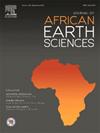Ecological differences in upper Pliensbachian (Early Jurassic) reef communities determined by environmental conditions in carbonate settings
IF 2.2
4区 地球科学
Q2 GEOSCIENCES, MULTIDISCIPLINARY
引用次数: 0
Abstract
Reef communities changed dramatically during the Early Jurassic as they recovered from the End-Triassic Mass Extinction. The Atlas Rift Zone in Morocco provided expansive shallow water substrate, which allowed a variety of reef communities to develop, such as lithiotid bivalves that established themselves as new and prolific reef builders alongside corals, microbialites, and sponges in the Sinemurian and Pliensbachian stages. To better understand the dynamics between these reef builders and their environments, a detailed facies analysis of upper Pliensbachian reefs and a quantitative analysis of their composition was undertaken. We describe two distinct environmentally controlled reef types in the Central High Atlas Mountains. Lithiotid bivalves dominated reef construction in lagoonal environments and, together with phaceloid corals, commonly built bioherms and biostromes that ranged from 1 to 2 m tall and up to several hundred meters wide. Meanwhile, on the platform edge, microbialites, corals, and sponges constructed patch reefs up to 7 m tall and 20 m wide. These two reef types share common facies, as many of the same reef inhabitants, and some framework builders, grew in both environments. Despite the facies overlap, the communities in these two environmental settings are distinct, which is likely a result of environmental controls on the dominant reef framework builders. Moderately turbid waters and soft substrate in lagoons were ideal conditions for lithiotids but excluded many corals, sponges, and microbialites. Conversely, the clear, oligotrophic waters at the platform edge allowed photosynthetic and photosymbiotic organisms to thrive (e.g., coral and microbial reefs), while firmer substrate and higher wave energy may have prevented lithiotids from establishing dense populations.
碳酸盐岩环境条件决定了上Pliensbachian(早侏罗世)礁群落的生态差异
在侏罗纪早期,珊瑚礁群落从三叠纪末大灭绝中恢复过来,发生了巨大的变化。摩洛哥的阿特拉斯裂谷带提供了广阔的浅水基底,这使得各种珊瑚礁群落得以发展,例如,在Sinemurian和Pliensbachian阶段,与珊瑚、微生物和海绵一起,石类双壳类动物成为了新的、多产的珊瑚礁建造者。为了更好地了解这些礁石形成者与其环境之间的动态关系,对上Pliensbachian礁石进行了详细的相分析,并对其组成进行了定量分析。我们描述了中央高阿特拉斯山脉中两种不同的环境控制珊瑚礁类型。石类双壳类在泻湖环境中主导着珊瑚礁的建造,它们与类礁珊瑚一起,通常建造1至2米高、数百米宽的生物礁和生物层。与此同时,在平台边缘,微生物、珊瑚和海绵形成了高达7米、20米宽的斑块珊瑚礁。这两种类型的珊瑚礁具有共同的相,因为许多相同的珊瑚礁居民和一些框架建设者都在这两种环境中生长。尽管相重叠,但这两种环境条件下的群落是不同的,这可能是环境对主要礁架构建者的控制的结果。中度浑浊的水域和软底泻湖是石类的理想条件,但排除了许多珊瑚、海绵和微生物。相反,台地边缘清澈、少营养的水域允许光合和光共生生物(例如珊瑚和微生物礁)茁壮成长,而更坚固的基质和更高的波浪能量可能阻止了石类生物建立密集的种群。
本文章由计算机程序翻译,如有差异,请以英文原文为准。
求助全文
约1分钟内获得全文
求助全文
来源期刊

Journal of African Earth Sciences
地学-地球科学综合
CiteScore
4.70
自引率
4.30%
发文量
240
审稿时长
12 months
期刊介绍:
The Journal of African Earth Sciences sees itself as the prime geological journal for all aspects of the Earth Sciences about the African plate. Papers dealing with peripheral areas are welcome if they demonstrate a tight link with Africa.
The Journal publishes high quality, peer-reviewed scientific papers. It is devoted primarily to research papers but short communications relating to new developments of broad interest, reviews and book reviews will also be considered. Papers must have international appeal and should present work of more regional than local significance and dealing with well identified and justified scientific questions. Specialised technical papers, analytical or exploration reports must be avoided. Papers on applied geology should preferably be linked to such core disciplines and must be addressed to a more general geoscientific audience.
 求助内容:
求助内容: 应助结果提醒方式:
应助结果提醒方式:


